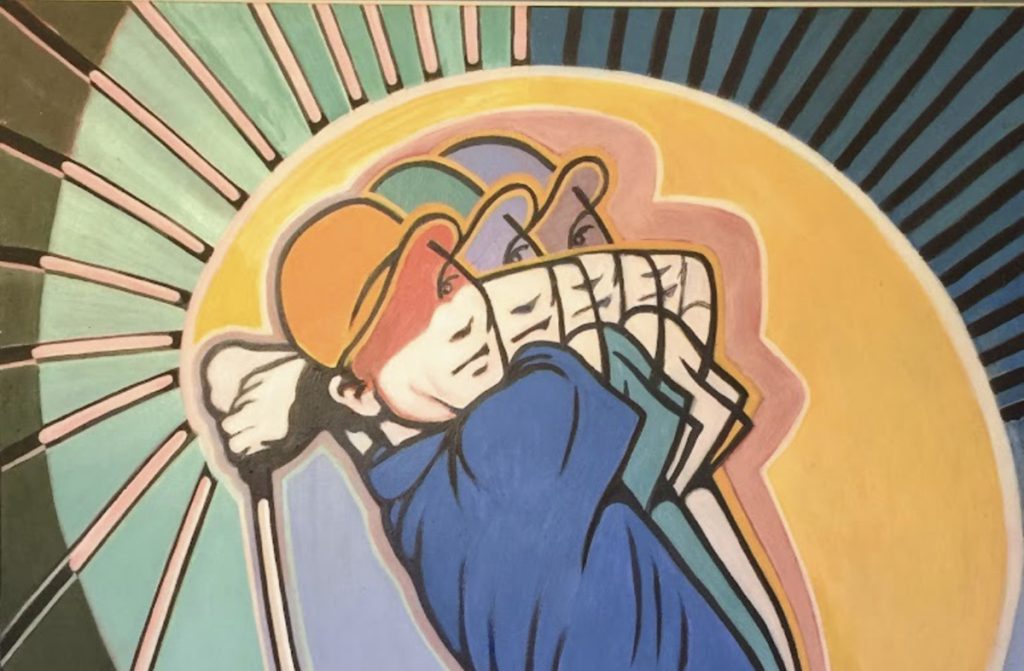Francisco Merello’s piece Swinging Through Colors: The Art of Motion in Golf is a vivid meditation on movement. At first glance, it captures a golfer mid-swing, but what unfolds across the canvas is far more layered. Rather than freezing the figure in one instant, the painting translates time into overlapping rhythms of color. The work is not only about sport—it’s about the flow of energy, the cycles of effort, and the beauty of motion itself.

The artwork greets the viewer with bold hues that vibrate against each other. Deep blues and warm reds mark the starting point of the swing. Yellows and greens push the movement forward. Each shade appears like a beat in a score, guiding the eye along the path of the golfer’s arc. There is no single figure here, but rather a sequence—gestures stacked on one another like echoes. The viewer senses not only the moment of contact but also the preparation, release, and follow-through.
Merello relies on repetition as both structure and disruption. Each layered figure overlaps with the next, creating a visual stutter that simulates motion. This repetition turns the canvas into a timeline. What could be a static portrait instead becomes alive, vibrating with unseen forces. The viewer feels the swing as an act of grace and intensity—balanced between precision and abandon.
The golfer, though central, is not the sole subject. The colors themselves take on equal weight. In many ways, the figures dissolve into color, leaving behind a trail of pure sensation. This shift reminds us that motion is not just physical but also emotional. We recognize energy not only through form but also through the moods colors carry. The reds suggest momentum, the blues stability, the greens possibility. Together, they create a chorus that echoes the visceral thrill of a swing well taken.
Compositionally, Merello plays with balance and imbalance. The forms lean into diagonals, pulling the viewer’s gaze from one edge of the canvas to the other. Yet the grounding tones, especially the darker strokes beneath, hold the work steady. This tension is deliberate—it mirrors the physical act of swinging, which is both controlled and unpredictable. The player rehearses precision, but the outcome always carries an element of chance.
What emerges, then, is a painting that sits at the intersection of sport, art, and philosophy. The golf swing becomes a metaphor for life’s cycles: preparation, action, release, and recovery. Each layer of color is not just a visual device but a chapter in that sequence. Merello shows us that motion cannot be contained by a single instant. To capture it, one must embrace multiplicity.
The title, Swinging Through Colors, anchors the piece in this philosophy. The golfer is swinging not only through air and gravity but through a spectrum of human emotion. The act is physical, yes, but also spiritual. By layering color over color, Merello gives form to the intangible—time itself.
Seen within the larger arc of his practice, the work connects to Merello’s ongoing exploration of the human condition. Just as his abstract and symbolic works examine our place in society, here he turns the spotlight on individual motion as a universal theme. The swing is specific, yet anyone can identify with its rhythm. It is about striving, following through, and accepting both control and chaos in one act.
Swinging Through Colors succeeds because it does not settle for being a depiction of sport. It elevates the swing into an emblem of vitality. The painting is both a study of form and a meditation on presence. It suggests that art, like motion, is not about stasis but about energy unfolding.

